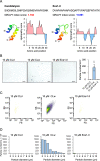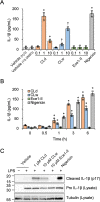Solubility affects IL-1β-producing activity of the synthetic candidalysin peptide
- PMID: 36040970
- PMCID: PMC9426886
- DOI: 10.1371/journal.pone.0273663
Solubility affects IL-1β-producing activity of the synthetic candidalysin peptide
Abstract
Candidalysin, a peptide toxin produced specifically from hyphae of Candida albicans, plays a crucial role in C. albicans pathogenesis in the oral cavity and vagina. Synthetic peptides have been widely used in previous studies to investigate the bioactivity of candidalysin. Although the solubility of the peptide, which is expected to have a hydrophobic property, has not been well characterized, candidalysin solutions are usually prepared in water. In this study, we prepared the synthetic peptide candidalysin in water (CLw) or in dimethyl sulfoxide (CLd) and compared their cytotoxicity and interleukin (IL)-1β-producing activity to determine whether the activity of the peptide would be affected. In addition, we evaluated whether the NOD-like receptor family pyrin domain-containing 3 (NLRP3) inflammasome pathway or other pathways were involved in their activities. Unexpectedly, we found that CLw was not completely solubilized and contained abundant insoluble microparticles. CLw was active at comparably high concentrations (≥ 10 μM). In contrast, CLd is completely solubilized and sufficiently active at low concentrations, that is, 1 μM or less. CLw showed weak cytotoxicity and NLRP3-dependent and cathepsin B-dependent IL-1β-producing activity, whereas CLd showed strong cytotoxicity and cathepsin B-dependent IL-1β-producing activity. Fractionation of CLw revealed that NLRP3-dependent activity was caused by insoluble microparticles. Furthermore, nanoparticle tracking of CLd revealed that the peptide was present as nanoparticles with a size of 96 nm. CLw contained a small amount of such nanoparticles. Thus, the bioactivities of the synthetic peptide candidalysin, especially the IL-1β-producing activity, are affected by the solubility of the peptide depending on the solvent employed. The NLRP3-dependent activity of the synthetic peptide is caused by insoluble microparticles and may not be the intrinsic activity of candidalysin.
Conflict of interest statement
The authors have declared that no competing interests exist.
Figures








Similar articles
-
Effect of NLRP3 deficiency on cytotoxic and IL-1β-producing activities of synthetic candidalysin peptide.J Oral Biosci. 2023 Dec;65(4):287-292. doi: 10.1016/j.job.2023.08.007. Epub 2023 Aug 31. J Oral Biosci. 2023. PMID: 37659475
-
Candidalysin Crucially Contributes to Nlrp3 Inflammasome Activation by Candida albicans Hyphae.mBio. 2019 Jan 8;10(1):e02221-18. doi: 10.1128/mBio.02221-18. mBio. 2019. PMID: 30622184 Free PMC article.
-
Second-Generation Antidiabetic Sulfonylureas Inhibit Candida albicans and Candidalysin-Mediated Activation of the NLRP3 Inflammasome.Antimicrob Agents Chemother. 2020 Jan 27;64(2):e01777-19. doi: 10.1128/AAC.01777-19. Print 2020 Jan 27. Antimicrob Agents Chemother. 2020. PMID: 31712208 Free PMC article.
-
The role of Candida albicans candidalysin ECE1 gene in oral carcinogenesis.J Oral Pathol Med. 2020 Oct;49(9):835-841. doi: 10.1111/jop.13014. Epub 2020 Apr 18. J Oral Pathol Med. 2020. PMID: 32170981 Review.
-
[Advances in mechanisms for NLRP3 inflammasomes regulation].Yao Xue Xue Bao. 2016 Oct;51(10):1505-12. Yao Xue Xue Bao. 2016. PMID: 29924571 Review. Chinese.
Cited by
-
Candidiasis in Pregnancy: Relevant Aspects of the Pathology for the Mother and the Fetus and Therapeutic Strategies.Trop Med Infect Dis. 2024 May 15;9(5):114. doi: 10.3390/tropicalmed9050114. Trop Med Infect Dis. 2024. PMID: 38787047 Free PMC article. Review.
-
Sulfated glycosaminoglycans are host epithelial cell targets of the Candida albicans toxin candidalysin.Nat Microbiol. 2024 Oct;9(10):2553-2569. doi: 10.1038/s41564-024-01794-8. Epub 2024 Sep 16. Nat Microbiol. 2024. PMID: 39285260 Free PMC article.
-
Nanobody-mediated neutralization of candidalysin prevents epithelial damage and inflammatory responses that drive vulvovaginal candidiasis pathogenesis.mBio. 2024 Mar 13;15(3):e0340923. doi: 10.1128/mbio.03409-23. Epub 2024 Feb 13. mBio. 2024. PMID: 38349176 Free PMC article.
-
Recombinant DNA the Bio-Revolution, Between Promise, Hurdles, and Achievements.Int J Mol Sci. 2025 Jul 10;26(14):6611. doi: 10.3390/ijms26146611. Int J Mol Sci. 2025. PMID: 40724860 Free PMC article.
-
A genome-scale screen identifies sulfated glycosaminoglycans as pivotal in epithelial cell damage by Candida albicans.bioRxiv [Preprint]. 2024 May 23:2024.05.23.595417. doi: 10.1101/2024.05.23.595417. bioRxiv. 2024. PMID: 38826446 Free PMC article. Preprint.
References
Publication types
MeSH terms
Substances
LinkOut - more resources
Full Text Sources
Research Materials

